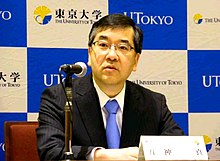Makoto Gonokami
Makoto Gonokami (五神 真, Gonokami Makoto, born 1957) is a professor of science and engineering in University of Tokyo mostly in physics field. Since April 2015, he has been 30th president of the University of Tokyo succeeding Junichi Hamada who retired in 2015.[1][2]
Professor Makoto Gonokami | |
|---|---|
 UTokyo conference 2018 | |
| Born | 1957 |
| Nationality | Japan |
| Education | University of British Columbia |
| Alma mater | University of British Columbia |
| Occupation | Researcher, teacher |
| Title | President of University of Tokyo |
| Term | April 2015 |
| Predecessor | Junichi Hamada |
He works in the graduate school of science, school of engineering in the institution before being dean in graduate school of science and vice president of the university.[3][4]
He holds a PhD in optical physics at University of British Columbia and most of his research based on Quantum physics and participate in Center for Quantum Materials.[5][6]
Notes
- "Bloomberg - profile of Makoto Gonokami". www.bloomberg.com. Retrieved 2020-07-25.
- "Makoto Gonokami Begins UTokyo Presidency". Friends of UTokyo, Inc. 2015-07-14. Retrieved 2020-07-25.
- Murai, Shusuke (2015-05-22). "Head of Todai is an advocate for collaboration and diversity". The Japan Times. Retrieved 2020-07-25.
- "Makoto Gonokami". APRU. Retrieved 2020-07-25.
- "Makoto Gonokami | Office of the President". president.ubc.ca. Retrieved 2020-07-25.
- "GONOKAMI Makoto". The University of Tokyo. Retrieved 2020-07-25.
- "IARU Presidents". www.iaruni.org. Retrieved 2020-07-25.
| Academic offices | ||
|---|---|---|
| Preceded by Junichi Hamada |
President of University of Tokyo April 2015 - |
Succeeded by current |
gollark: Probably not though, lots of people are annoyed by me.
gollark: To wildly stereotype possibly incorrectly, something something bipolar disorder?
gollark: Factually incorrect.
gollark: We do have metahypercapitalistic parallelized arbitrage engines, of course.
gollark: We don't have "GTech™ money generator".
This article is issued from Wikipedia. The text is licensed under Creative Commons - Attribution - Sharealike. Additional terms may apply for the media files.